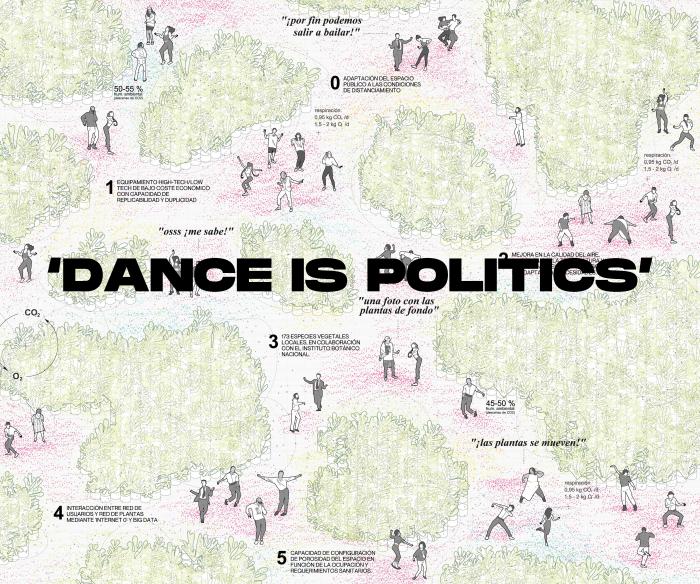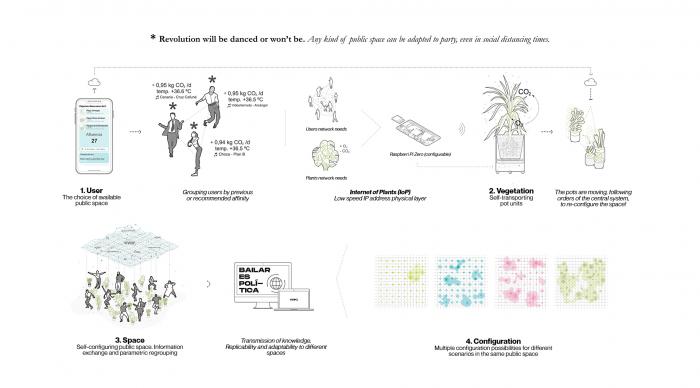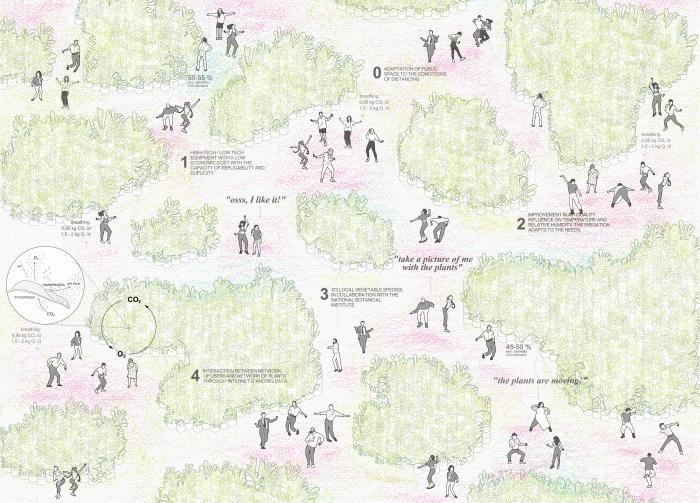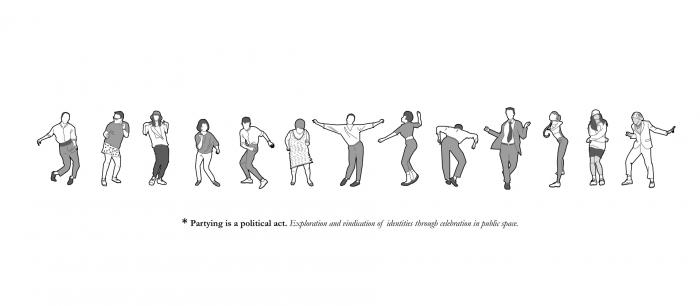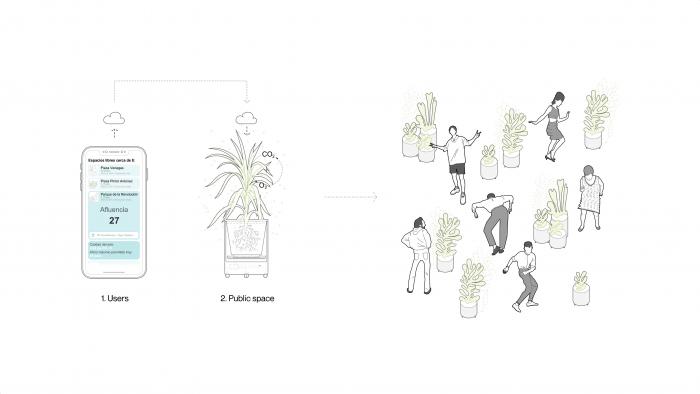I. SUMMARY INFORMATION
Project
268701
Status
Submitted
Award category
Reinvented places to meet and share
You want to submit
NEW EUROPEAN BAUHAUS RISING STARS : concepts or ideas submitted by young talents (aged 30 or less)
Project title
Dance is Politics.
Full concept/idea title
Dance is Politics. Claiming identities through celebration in public space.
Description
The project reclaims the appropriation of the public space through 'the party' and dancing as a social catalyzer during -and after- the pandemic, establishing a new paradigm in which technology, environment, and social encounter merge in a single reproducible architectural strategy.
Where is your concept/idea being developed or intended to be implemented in the EU?
Spain
Canary Islands
-
Las Palmas de Gran Canaria
-
II. DESCRIPTION OF THE PROJECT
Please provide a summary of your concept/ idea
Parties or celebrations of any kind are a backbone for identity claim and public representation for communities of different sizes and nature, becoming an essential political tool for visibility and a driving force for social change. Not as a frivolous gimmick, but being aware of the crucial role of partying and dancing in expressing and reaffirming community identities through collective celebration and occupation of the public space. We understand partying in public space as a political act.
But, in the ongoing health crisis, what happens to an activity based on agglomeration? We must find a party model compatible with a delicate social and sanitary situation. Social distancing creates a void between us destined to be unused, but why not take advantage of it to fill it with nature? We are given the opportunity to shape the future, and we cannot imagine one that does not go hand in hand with technology and nature.
DANCE IS POLITICS is an idea easy to build, with just a few components: people, music, plants, and the desire to dance. We propose a system made of a physical component and a virtual one in continuous feedback. The physical part is a system of pots that move automatically to create various groupings of vegetation to limit agglomerations and ensure social distancing. The virtual component consists of a central system for analyizng and managing the data collected through sensors, which transmits information in real-time to each pot on where to move in the urban space. The units that comprise the system are flowerpots: mobile elements that consist of vegetation, wheels, and a micro-computer, which allows their automation and directs their movement, following the central system's orders to which they are connected wirelessly. The information generated and collected in each of the public spaces creates an open-knowledge network, enabling the system to adapt to any public space and to any budge
Please give information about the key objectives of your concept/idea in terms of sustainability and how these would be met
Rather than tackling sustainability from a material point of view, we tackle it from its basis; we do not build. However, we propose an infrastructure that allows building communities through the use of vegetation. Through the inclusion of plants in our project, we provide the necessary elements to foster new social encounters and experiences.
Additionally, we believe in a broader meaning of sustainability. Sustainability for us means also care and a sense of community. It means creating inclusive environments for all forms of life, in which the ecologic part is, of course, a cornerstone.
Please give information about the key objectives of your concept/idea in terms of aesthetics and quality of experience beyond functionality and how these would be met
The idea of DANCE IS POLITICS is about enhancing the urban space through nature and experience. The flooding of public spaces with nature to enable social encounter aims, on the one hand, to include vegetation in the cities, in order to create a greener and kinder environment. This concept is adaptable to any city and its local vegetation, generating an idea that is adaptable to any situation. The aesthetic value of vegetation in cities and public spaces blends with the experiential idea of the party as a social catalizer. On the other hand, celebrations in public spaces aim to permit anybody to express themselves freely through the experience of party and the occupation of the public space as a method for reclaiming rights and identities. As Victor Turner puts it, to enter a party is to enter "into a collective, creative transformation of identity, time and space separated from everyday reality." This experience opens the possibilities to a parallel world that allows for the subversion of hegemonic social conventions.
We also believe that a key feature of the project is that it does not limit its operation to a single type of ‘experience’ but allows adapting the public space to different audiences and needs.
Dancing and partying are carried out as an act of corporal expression, almost as a way of liberation. That is something that seems complicated to do safely in the current situation. We emphasize that because, at different times in history, it meant an act of social claim even though, a priori, it might seem somewhat naive.
The relation between music, body, and dance creates a communal experience that allows for exploring multiple alternative models to those socially established.
Please give information about the key objectives of your concept/idea in terms of inclusion and how these would be been met
‘The party’ especially those discordant with the established leisure model - has always been used as a tool for protest and to reclaim rights and public spaces. Block parties, raves, carnivals, or popular celebrations of any kind are an example of that.
The origins of house music represent this idea. As has happened with other music and festive movements — such as rap, reggaeton, or funk carioca — the same pattern repeated itself. These movements were first ignored or directly repressed, then claimed, and later used or absorbed by large-scale popular movements. In the absence of 'official' leisure and recreation circuits that would welcome them, many self-organized celebrations originally served as an escape valve.
We aim for a system that permits the use of public space for creating. The project creates an infrastructure that would enable these encounters to happen, despite the sociosanitary situation. We aim for a recreational model in which anybody can be represented, a new model of celebration in public space in which the interaction of humans and nonhumans establish a new way of celebrating. "By claiming space in public, by creating public spaces, social groups themselves become public.” (Don Mitchel, 2003)
Like Nancy Fraser, we argue that the notion of a singular universal public sphere needs to be replaced with a theory of multiple, contending, often mutually exclusive public spheres. Our idea accommodates this multiplicity through its flexible and adaptable system.
Also, representation, whether of oneself or of a group, demands space. In public space political organizations can represent themselves to a larger population. By claiming space in public, social groups themselves become public. Our project acts as a mechanism of enabling people to make themselves visible on the streets.
Please explain the innovative character of your concept/ idea
The project establishes a new paradigm in which technology, environment, and social encounter merge in a single reproducible architectural strategy.
The innovative character of the concept lies upon the fact that, with minimal elements; nature, and technology, we create a suitable environment for public celebration, taking into consideration its social implications. With these elements, we create a greener urban environment and a sustainable and inclusive community. The prototype, a network of interconnected nature, - which is in itself, an innovative concept- allows for the creation of cities without building, and creates stronger human and non-human networks. After all, that is what we understand about sustainable architecture; it has potential to make a change on the cities and the beings that inhabit them.
Please detail the plans you have for the further development, promotion and/or implementation of your concept/idea, with a particular attention to the initiatives to be taken before May 2022
The idea was conceived as a tool for raising awareness about the importance of public celebration in the public space. As such, the communicative aspect of the project and its broadcasting and outreach is essential to its success.
We have several plans for continuing developing the idea, taking the form of theoretical and practical approaches. DANCE IS POLITICS is an ongoing research about the role of ‘the party’ in expressing and reaffirming community identities through the occupation of public space. The outcome of this two-year-long research is going to be published in different media during 2021 and 2022; in online platforms such as Koozarch, or books and magazines, such as L’Atelier Magazine. Additionally, the project will take on a physical approach too. We will co-run workshops and participate in festivals and events, which will, on the one hand, let us continue exploring this topic in a practical way and, on the other, broadcast the outcomes to the wider public.
We will develop this idea in collaboration with Theatrum Mundi in the Movement Forum, in Fall 2021 throughout three labs in London, Paris, and Lisbon. We will develop Dance is Politics as a methodology for embodied space-making in relation to questions of mobility justice in each city. Inviting a local choreographer to conceive of a collective movement responding to each theme, we will stage a party as an experiment in temporary transformation of socio-spatial conditions. The result of these labs will be edited and published in a series of research books in Fall 2021. Also, the results will be presented in the Trienal de Lisboa.
Moreover, the idea Dance is Politics is participating in the Driving the Human Festival in October, 2021, in Berlin, showcasing the results of their research in the form of an artistic exhibition.
Additionally, the development of the physical/digital prototype of the project - after several discussions with a team of robotic engineers and developers - would depe
III. UPLOAD PICTURES
IV. VALIDATION
By ticking this box, you declare that all the information provided in this form is factually correct, that the proposed concept/idea has not been proposed for the New European Bauhaus Rising Stars Awards more than once in the same category.
Yes
